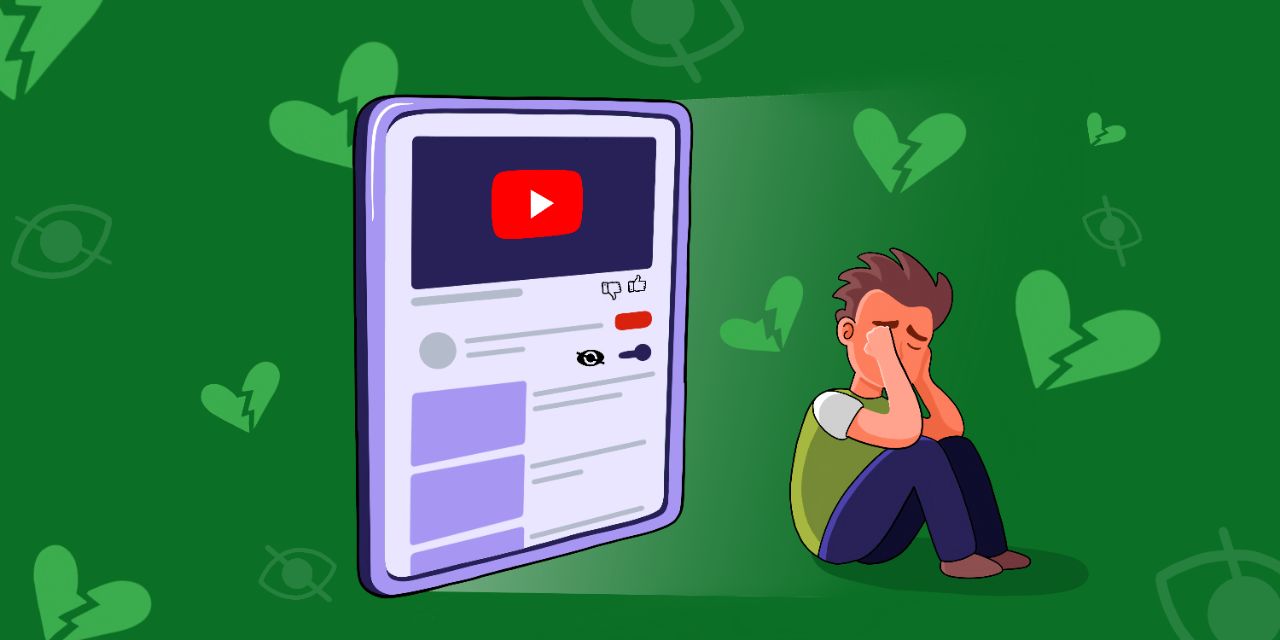Top 4 Reasons Your YouTube Channel is Not Gaining Views

90% of YouTube creators believe in the existence of shadow banning, where the platform intentionally limits their views. It's convenient to blame a lack of views on shadow banning or the fact that people aren't subscribing.
But here's the truth: there is no such thing as shadow banning. In most cases, the absence or decrease of views is a result of the creators' own actions. You simply need to create good content and adhere to the platform's rules, as YouTube doesn't really care about you.
Blaming YouTube and magical shadow bans allows creators to shift responsibility away from themselves. It's a convenient explanation, but it prevents you from objectively assessing your channel and its content. If you want to remain in this position, no one will force you to find a solution. However, if you don't want to, you'll have to take control and start identifying your own mistakes and shortcomings.
YouTube has a universal working formula that, when executed properly, will always generate views: idea, packaging, video. Let's go through it step by step.
Top 1: Bad Video Topic
Before selecting and approving your chosen topic, ask yourself the following question: "What does my audience value in my niche: quality or quantity?" The answer to this question will determine everything: how much effort and depth you should put into your videos, how frequently you should release content to maintain high engagement on your channel, and whether your viewers are willing to watch videos despite a lower quality.
For example, there are news channels that people subscribe to because they need to stay updated on important events. They are less concerned about content quality, and what matters most is relevance, frequency, and the accuracy of the information provided by the creator.
On the other hand, there are historical channels where viewers value carefully researched material that is enjoyable to listen to and watch. Here, the demands for quality are significantly higher, and viewers don't expect this content to be produced on a daily basis. In this case, quality content is paramount.
The first thing you need to do is reduce the quantity of your publications and focus on quality. That's a guarantee for increasing your views. If you're confident that you've done everything correctly in this regard, then consider more common reasons for low views. The chosen topic of your videos may be boring, not in demand, too narrow, or simply outdated.
To determine whether any of these factors have contributed to low views, search for videos on your topic. If you can't find any, it's likely that the topic is either too narrow or not in demand. Conduct additional research using tools like Google Trends.
If there are existing videos on the topic, compare how they are made with your own. It's possible that you have fallen behind in terms of quality. And if there are videos available but they also have low views, it could be that the topic itself is not engaging and people are not particularly interested in it.
To avoid harming your channel at this stage:
- Look at popular video topics in your niche, see what competitors or colleagues are creating new content on. Define your quality standard and start developing your content accordingly.
- Review your old popular videos and assess what would be better for them: to reshoot them or create a series of videos around the same topic.
To avoid trying to force good topics when it's time to create content, make it a habit to spend time brainstorming and generating ideas. Come up with a hundred ideas, any kind: silly, naive, difficult to implement. Choose ten great and feasible ideas from them, and then select the very best one.
If you consistently follow this approach, you will have a reserve of pre-approved, successful, and in-demand video topics.
Top 2: badly designed video (bad thumbnail or title)
The most common problem that can result in low views or a decrease in views is the lack of appealing visuals or design. Your current design may be acceptable to the number of subscribers you have at the moment. However, you won't grow because those who are not satisfied with your design or feel that it doesn't provide them with sufficient information about the video will not start watching your content.
Until you compare your design with the designs of other videos in your niche and start working on improvements, viewers will not trust your content, and it will continue to fail to generate the desire to click on your video.
This doesn't mean that you urgently need an incredibly cool and expensive thumbnail. Sometimes, it's enough for your design to be better than the majority. Show a little creativity, and viewers will be happy.
- The presentation and creativity of the thumbnail can make all the difference
Some creators don't necessarily need to use clickbait or flashy phrases, or obsess over perfect proportions. It's enough to approach the process creatively: bring life to inanimate objects, break the system, and use objects in unconventional ways.
When working on thumbnails, create multiple concepts and variations to compare and choose the best option. To ensure you don't miss the mark, conduct a community poll to vote for the best design for your next video. Nobody can tell you more precisely than your audience.
The main task of thumbnails is to catch the viewer's attention. Therefore, there is a certain psychology behind video design: the most clickable thumbnails are those that evoke emotion and curiosity without spoiling the video's content. Often, authors achieve this by using their own facial expressions to convey a specific emotion, allowing viewers to relate and feel a connection with the video.
However, we must not forget that when we talk about video design, we also refer to its title.
- The title of the video always works in tandem with the thumbnail.
Therefore, even the most incredible thumbnail can be overlooked if it is accompanied by text like, "My Day in the Village." Who wants to spend time watching someone's day in some random village?
You must intrigue and focus on what interests your audience. Following the same brainstorming process you use for video ideas, sit down and come up with a heap of titles from which something truly compelling will emerge.
- Don't forget to spend time on analytics
You should search for the most popular videos, videos with the highest and lowest click-through rates, videos with the lowest watch time, and analyze why certain thumbnails work and attract viewers while others don't.
At some point, you'll start noticing patterns and understanding what your audience likes and dislikes about your thumbnails. And, of course, keep an eye on your competitors!
When studying the thumbnails of successful videos, avoid copying them. Instead, think like a strategist. Dig deeper to understand what exactly made that thumbnail resonate with viewers. Was it the color scheme, specific objects, or the text? Be precise and test all your ideas.
Top 3: Poor video intro
If your introduction is boring, unappealing, and fails to grab attention, viewers will not continue watching. And if a viewer watches less than 2-3 seconds of your video, it won't count as a view. This is why you may have a low number of views and a decline in viewership.
The introduction is the most important part of your videos. It is where viewers make the decision to continue watching or not. Your ability to capture and hold the viewer's attention is demonstrated in the introduction. Even if the content inside the video is amazing, like a homemade Cirque du Soleil, it won't matter if you miss your chance in the beginning of the video.
How do you determine what should be in the introduction? After all, some viewers appreciate a heartfelt and unhurried storytelling approach, while others value straight facts and don't want to waste a minute.
The universal answer is to try different formats and then use analytics to assess which videos were more successful in retaining viewers in the beginning. YouTube itself has introduced a separate metric for analyzing video introductions. It's a not-so-subtle hint from the platform on what you should focus on and work on.
Checklist for a successful YouTube video intro
- Ask yourself two questions before every video: "What problem is being solved?" and "What does it offer to the viewer?" If both answers are provided within the first 15 seconds of the video, congratulations, you have done an excellent job.
- With over 3.5 million videos being uploaded to YouTube daily, it's important not to waste time and get straight to the point in your video. It's crucial to quickly grab the viewer's attention.
- The most effective method to improve the beginning of any video is to jump right into the storyline. Ask yourself, "What do viewers want to learn from this video?" and deliver it as quickly as possible.
- Paddy Galloway, one of the top YouTube consultants who has worked with prominent creators like MrBeast and PewDiePie, suggests that 30-40% of the editing time should be dedicated to the first minute of the video.
- Take the time to plan and craft engaging introductions in advance. Think about which hooks or statements will immerse the viewer into watching the video.
Another approach is to focus on storytelling rather than getting caught up in the production process. No amount of shooting in 4K resolution or having the highest number of pixels per square nanometer will help if your story is a complete disaster.
Today's viewers are discerning, and they want to see a certain level of quality in videos. However, sometimes incredible stories can be so captivating that they forgive other shortcomings.
A simple example from life is the quality of movies made before the 1980s and 1990s. They may not match up to today's technical standards, but some films touch our hearts to such an extent that we would never prefer remakes. "The Godfather," "Some Like It Hot," "Gone with the Wind," Charlie Chaplin films—the list goes on.
Another method is to watch your videos several times before uploading them. Not all creators can boast that they approach the editing and uploading stage meticulously. Some don't even review their footage and instead upload three-hour streams, leaving the audience to figure it out. They think, "I've done my part—now it's your problem."
If you don't care about your viewers, why would you expect them to show understanding towards you? You need their views, not the other way around.
Therefore, double-checking your video multiple times before uploading is an important aspect of caring for your viewers. It's best to watch the video at least three times. The first time is during the editing stage, the second time is to identify any parts that might drag on and make notes, paying attention to all the details that need to be removed or added. The third time is when you put on your critical eye and make final adjustments to the video: ensuring all captions are in the right place and checking for any errors.
Very often, as you go through the structure of the video during the editing process, you may come up with interesting ideas to make the video even better, more engaging, and vibrant.
Finally, let me address one last point: analyze your actions.
Instead of stumbling upon the same mistakes with every edit, write them down and keep them in front of you. By remembering past mistakes, you become more professional with each iteration. You'll start focusing on more important aspects, such as extracting the juiciest moments, instead of constantly revisiting small errors that could be corrected at the initial editing stage.
Here's another small thought: a significant portion of our viewers watch videos on their smartphones. When they open the app and scroll through their feed, videos start playing automatically. If your video begins with a splash screen, monotonous greetings, or anything that doesn't engage them from the first few seconds, you're losing the viewer. They move on and forget that you had something to say.
Therefore, it's crucial to grab their attention right from the start, considering that they may be watching on mobile devices. Make sure your videos begin with compelling content that immediately captivates the viewer. Avoid unnecessary introductions or lengthy greetings that hinder their engagement.
By analyzing your actions and continuously improving, you can create videos that not only resonate with your audience but also keep them hooked from the very beginning.
Top 4: Boring videos
The adjective "boring" here includes quite a few definitions: lack of dynamics, absence of atmosphere, excessive pauses left within the video, poor work on the plot and/or script.
As a result, people may simply not watch your videos for these reasons, or they may watch but not subscribe, or the number of views may decrease with each video. It's because viewers have choices—they can find something more interesting to view.
It often happens that a channel grows and develops, but suddenly experiences a decline in views and a loss of viewer interest.
- Start by studying your competitors. Check if you're falling behind. There's a high chance that someone in your niche is creating similar content but better or more interesting than yours. It's possible that viewers are tired of monotony, or your format may have become outdated.
- Try introducing something innovative that hasn't been seen on your channel before. Look for cool ideas or segments from vloggers in other niches and adapt them to your own. For example, if you have a channel focused on reviews and there's a beauty niche (makeup, haircare, skincare), you can take inspiration from the review format and not only showcase makeup and hairstyles but also do various unboxing and reviews of cosmetic products.
- Gather a focus group. Editing is not the final stage before publishing a video. Let your friends or acquaintances tell you what bored them, what was unnecessary, and what they liked. If you don't have the opportunity to receive feedback, become your own focus group and evaluate your video objectively, as a viewer.
- Remove distractions, turn off background noise, and simply watch your video from start to finish. If you feel the urge to be distracted by your phone or shift your attention to what's happening outside the window, chances are your viewers will feel the same. This means you need to make some changes. If you find your own video boring to watch, then a stranger definitely won't want to waste their time.
- Help viewers digest long videos. Chapters or episodes are an ideal way to assist your viewers. If they feel bored at some point or if the information becomes repetitive, they can easily skip to another part of the video instead of completely giving up on watching and losing interest.
Creators who don't work with a structure can fall into a trap. Therefore, don't forget that every video needs storytelling: an introduction, main part, and conclusion. Even vlogs have a structure, though it may just revolve around a single day in someone's life. But even a routine can be divided into segments like morning and breakfast, work time, and evening. Engage your imagination. - Never promise something that isn't in the video. Not in the thumbnails, intros, or description. Viewer dissatisfaction will grow with each minute watched, and they will not only stop watching the video but may also leave the channel. In the long run, making empty promises will only harm your reputation.
In the case of empty promises, you're only making things worse for yourself. It's like having a resume where you lied. Even if the employer couldn't catch you lying during the interview, the truth will eventually come out when you start the job and can't handle it. - Give viewers something to think about at the end of the video. Leave them with something memorable long after the video is over. It could be a successful joke, a well-integrated meme, an interesting, useful, or astonishing fact. But don't overdo it. Being remembered positively is different from being remembered negatively—it makes a big difference.
- You might find this information too simple, and the mistakes and advice too clichéd. But there are no secret techniques, tricks, or magic buttons. Channels decline primarily because of the creators themselves, and the platform is rarely to blame.
Therefore, ask yourself hard questions when difficult times come to your channel. Only you will be able to bring your videos to light. Good luck!




